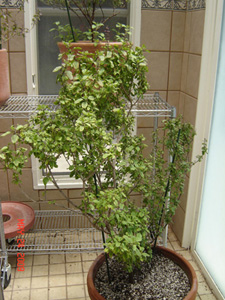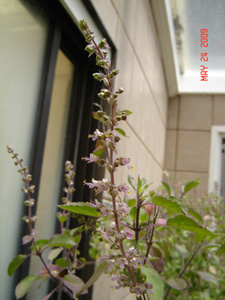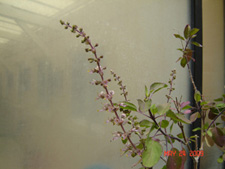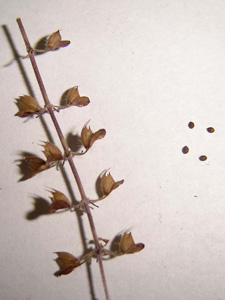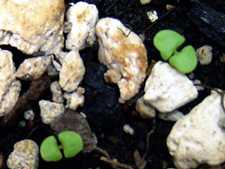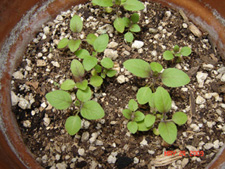
Srimati Tulasi Devi
Click on the pictures for larger view (you must have javascript enabled)
Since she is the queen of plants I would like to start this page with the glories of Srimati Tulasi devi. We address her as such because she is actually a pure devotee of Lord Sri Krishna in plant form. By growing and worshipping Tulasi devi we may learn pure love and devotion to God, Lord Sri Krsna. She is all auspicious. The Lord will not accept an offering without a Tulasi leaf present.
Common Name(s): Tulasidevi, Tulsi, Holy Basil
Latin name: Ocimum sanctum
Plant Family: Lamiaceae
Country of Origin: India
Description: Tulasi plant, is a shrub reaching a height of 0.5 to 1.5 m ( 2 - 5 ft.) (see photo #1)
The leaves are 2-4 cm (1/2in. to 1-1/2 in.) in length. (see photo #2)
There are several varieties of the plant. The green Tulasi is called Rama Tulasi and the dark, purple leaved Tulasi is Krishna Tulasi. The inflorescence (manjari) is a long spike with tiny purple flowers. (see photo #3)
Fruits nutlets, smooth each with 4 seeds inside. (see photo #4)
The leaves are 2-4 cm (1/2in. to 1-1/2 in.) in length. (see photo #2)
There are several varieties of the plant. The green Tulasi is called Rama Tulasi and the dark, purple leaved Tulasi is Krishna Tulasi. The inflorescence (manjari) is a long spike with tiny purple flowers. (see photo #3)
Fruits nutlets, smooth each with 4 seeds inside. (see photo #4)
Cultivation: She thrives best in a tropical environment. At least 5 hours of sunlight per day. Ideal temperature is 80 degrees in the day and 65 degrees at night. In temperate areas she may be grown outdoors but will need protection in winter. However, in the climate of Santa Cruz, California she mostly lives indoors and requires extra lighting and heat in the winter.
Propagation: By seed. The best season for growing Tulasi plants is 15th April to 15th June although I always sow Tulasi on Sri Gaura Purnim. Use a nice potting soil. I prefer Black Gold. Fill a terra cotta pot with the soil or use a seed starter kit. Sprinkle about 10 seeds on top of the soil. Then sprinkle lightly more soil over the seeds about 1/4 in. thick (Be careful of how many you sow as if all 10 seeds sprout you will have 10 Tulasi's to take care of.) Mist the seeds daily. Seeds should sprout within 3-4 weeks. (see photo #5) Transplant when she reaches 3 inches high.
Pests and diseases: If she is indoors there are a variety of pests that can attack her such as mealybugs, spider mites, scale and white fly. If she is indoors it's vital that she be brought outside in warm weather for a good shower to keeps insects at bay. Also spraying her daily with a spray bottle full of water is helpful.
Uses: Only to be placed on offerings to the Lord. Some people use her medicinally but that is offensive as she is a pure devotee.
Location on the Seva Ashram property: She has her own greenhouse adjacent to the temple and prasadam rooms.
Hare Krishna Hare Krishna Krishna Krishna Hare Hare Hare Rama Hare Rama Rama Rama Hare Hare
